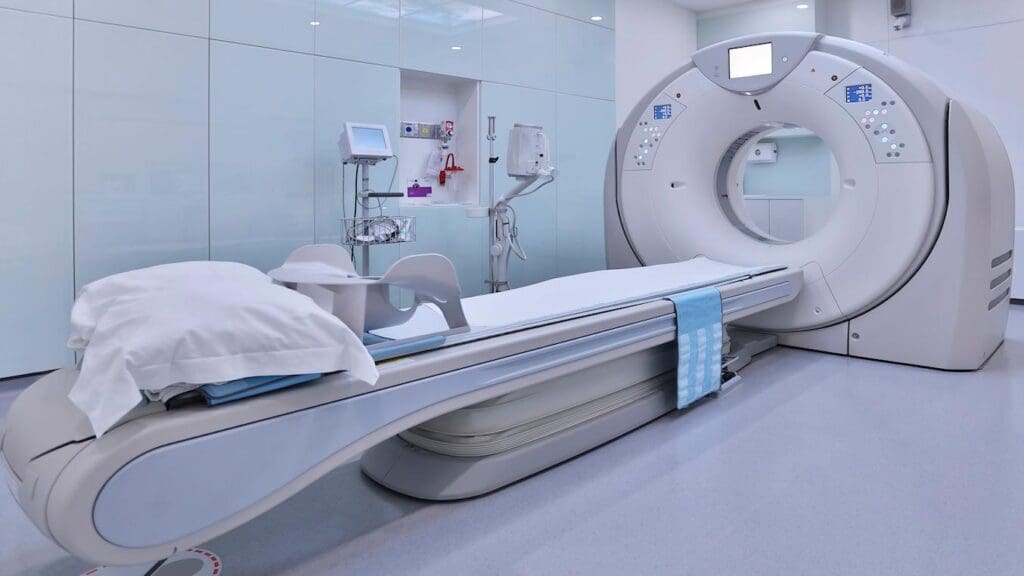Next-Generation PET Scanning: More Detail, Less Waiting
Early detection, crystal-clear imaging, and reliable results — all in the hands of experienced specialists dedicated to protecting what matters most: your health.
Discover the Power of Molecular Imaging.
Hospital Aranda de la Parra offers state-of-the-art Positron Emission Tomography (PET) services, delivering detailed images of your body’s metabolic activity. This advanced diagnostic system allows us to detect changes at the cellular level before structural abnormalities appear — a critical advantage for early diagnosis and precise treatment of a wide range of medical conditions, especially in oncology, neurology, cardiology, and urology, among others.
Our highly trained team of specialists uses a cutting-edge PET scanner that combines exceptional accuracy with shorter scan times, minimizing radiation exposure while maximizing image quality. This technology enables us to accurately assess disease extent, monitor treatment response, and plan personalized interventions based on each patient’s unique needs.
At Hospital Aranda de la Parra, we believe that medical imaging goes beyond detecting abnormalities. Molecular imaging is a powerful tool that guides personalized treatment, supports compassionate care, and provides a foundation for cutting-edge clinical research. Our state-of-the-art PET/CT technology enables faster scans, lower radiation doses, and exceptional image resolution—all to serve you better.
ADVANCED PET TECHNOLOGY
Our PET system — the GE Discovery MI — features a groundbreaking detector design that pairs a compact matrix with a lutetium-based scintillator (a crystal that lights up when exposed to radiation) and a silicon photomultiplier (a sensor that converts that light into digital signals). This high-sensitivity system extends the scan range to 20 cm in one go, improving both speed and precision.

What does this mean for you?
- Faster scans with less discomfort
- Reduced radiation exposure
- Enhanced detection of small or early-stage lesions
- Accurate tracking of disease progression with quantitative imaging
This level of detail is vital for tailoring treatments and monitoring response over time.
HIGH-PRECISION CT IMAGING
Sharper Images with Significantly Lower Radiation
Our CT technology isn’t just fast — it’s smart. It incorporates one of the fastest X-ray tubes available and a next-generation detector that doubles spatial resolution compared to standard systems. Even more impressive, it achieves up to 82% reduction in radiation dose, while maintaining excellent image clarity.
Key features include:
- Precise image quality across various diagnostic applications
- Virtual artifact removal — eliminating unwanted lines or shadows caused by metal implants
- Less time spent retouching or re-scanning images
All this leads to more accurate diagnostics in less time.
PET Scanning Pricing | Prices are approximate in USD or CAD
PET/CT 18F-FOC (Octreotide) – $35,629 MXN | $1,830 USD | $2,555 CAD
Purpose: Used to detect neuroendocrine tumors.
How it works: This scan uses a radiotracer called 18F-Fluoro-Octreotide, a synthetic version of somatostatin. It binds to somatostatin receptors commonly found in neuroendocrine tumors (e.g., carcinoid tumors, pancreatic neuroendocrine tumors, etc.).
Best for: Locating and monitoring tumors in the pancreas, lungs, intestines, and other organs that may express somatostatin receptors.
PET/CT F18-PSMA – $37,013 MXN | $1,900 USD | $2,655 CAD
Purpose: Primarily for prostate cancer detection and staging.
How it works: This scan uses F18-PSMA (Prostate-Specific Membrane Antigen), a molecule that binds to receptors found in prostate cancer cells. It’s highly sensitive and can detect cancer spread even at low PSA levels.
Best for: Diagnosing prostate cancer, especially recurrence or metastasis.
PET/CT FDG – $30,384 MXN | $1,560 USD | $2,180 CAD
Purpose: Used for a wide range of cancers and inflammatory conditions.
How it works: This is the most common PET scan, using FDG (Fluorodeoxyglucose), a type of glucose tagged with radioactive fluorine. Cancer cells consume more glucose than normal cells, so they “light up” on the scan.
Best for: Most cancers (lung, breast, colon, lymphoma), and sometimes for evaluating inflammation or infection.
PET/CT Sodium Fluoride (18F-NaF) – $20,491 MXN | $1,055 USD | $1,470 CAD
Purpose: Detects bone abnormalities and metastases.
How it works: This scan uses 18F-sodium fluoride, which binds to bone tissue and highlights areas of increased bone turnover, such as bone metastases, fractures, or other skeletal conditions.
Best for: Bone cancer staging, evaluating bone pain, or looking for metastatic disease in bones.
